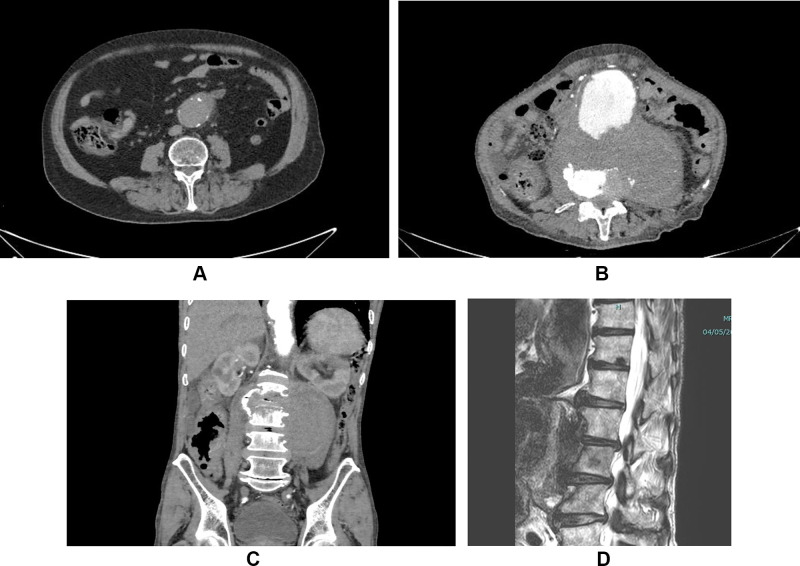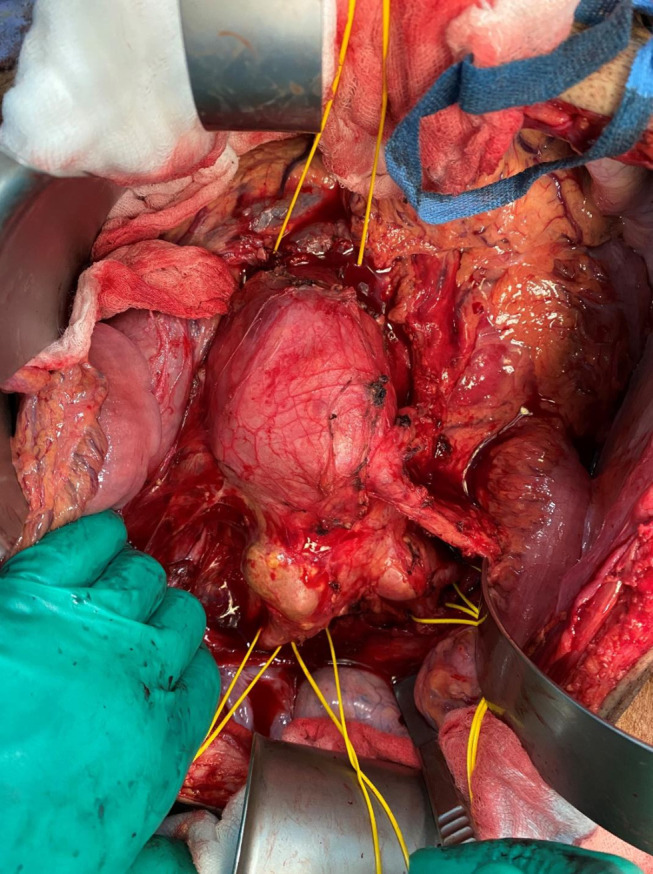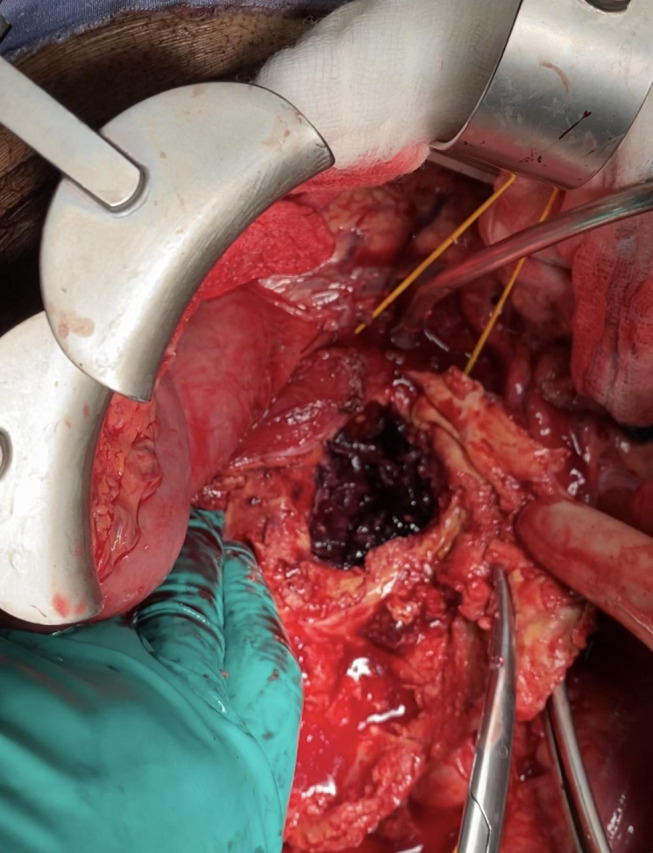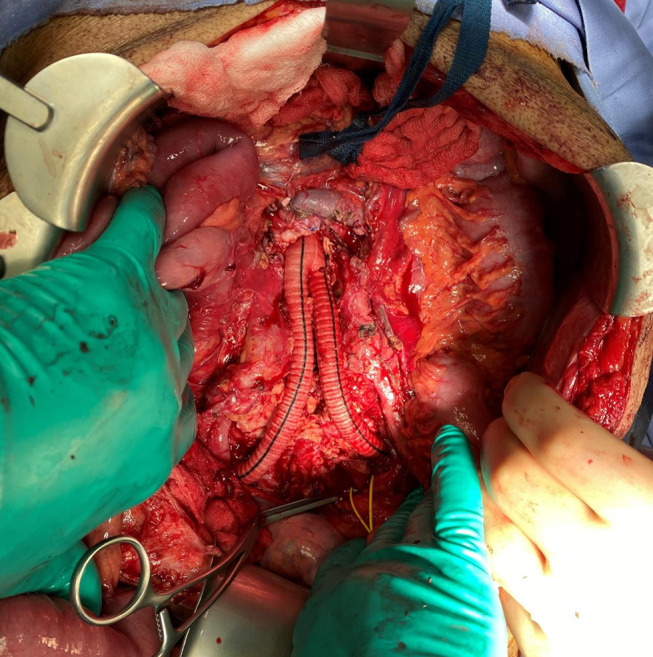Abstract
Background
The most lethal complication of the abdominal aortic aneurysm (AAA) is rupture (rAAA). A triad of abdominal or back pain, a pulsating mass in the abdomen, and decrease in blood pressure is mostly diagnostic. However, this presentation may not be complete due to either an impalpable aneurysm or atypical symptoms which leads to difficulties in diagnosis and delayed management. Chronic contained rupture of AAA (CCR-AAA) is a rare but well-recognized condition. Its diagnosis may be difficult because of the atypical and chronic nature of the symptoms. The aim of this study is to investigate the incidence and to highlight the importance of this less common presentation of rAAA.Methods
Patients who presented to King Abdullah University Hospital (KAUH) with infra-renal AAAs (elective and emergency) from January 2014 to April 2021 were prospectively collected. Patients with CCR-AAA were identified and evaluated in terms of demographic data, associated comorbidities, presentation, treatments, and outcomes.Results
A total number of 85 patients were admitted with an infra-renal AAA. Seventeen patients (20.0%) had rAAA, of them only 5 patients (29.4%) were diagnosed with CCR-AAA. CCR-AAAs represent 5.9% of cases with AAA. CCR-AAAs were all in men, with a mean age ± SD of 73.1±8.3. Two patients (40.0%) had abdominal pain, 2 patients (40.0%) had back pain and one patient (10.0%) had no symptoms at the time of diagnosis.Conclusion
CCR-AAA represents 5.9% of all AAA and 29.4% of rAAA. To prevent this potentially fatal condition, awareness is required especially in old males with abdominal or back pain.Free full text

Chronic Contained Rupture of the Abdominal Aortic Aneurysm
Abstract
Background
The most lethal complication of the abdominal aortic aneurysm (AAA) is rupture (rAAA). A triad of abdominal or back pain, a pulsating mass in the abdomen, and decrease in blood pressure is mostly diagnostic. However, this presentation may not be complete due to either an impalpable aneurysm or atypical symptoms which leads to difficulties in diagnosis and delayed management. Chronic contained rupture of AAA (CCR-AAA) is a rare but well-recognized condition. Its diagnosis may be difficult because of the atypical and chronic nature of the symptoms. The aim of this study is to investigate the incidence and to highlight the importance of this less common presentation of rAAA.
Methods
Patients who presented to King Abdullah University Hospital (KAUH) with infra-renal AAAs (elective and emergency) from January 2014 to April 2021 were prospectively collected. Patients with CCR-AAA were identified and evaluated in terms of demographic data, associated comorbidities, presentation, treatments, and outcomes.
Results
A total number of 85 patients were admitted with an infra-renal AAA. Seventeen patients (20.0%) had rAAA, of them only 5 patients (29.4%) were diagnosed with CCR-AAA. CCR-AAAs represent 5.9% of cases with AAA. CCR-AAAs were all in men, with a mean age ± SD of 73.1±8.3. Two patients (40.0%) had abdominal pain, 2 patients (40.0%) had back pain and one patient (10.0%) had no symptoms at the time of diagnosis.
Conclusion
CCR-AAA represents 5.9% of all AAA and 29.4% of rAAA. To prevent this potentially fatal condition, awareness is required especially in old males with abdominal or back pain.
Introduction
AAA is more than 50% dilatation in the diameter of the abdominal aorta.1 It is usually asymptomatic, symptomatic non-ruptured, and ruptured.2 Its rupture is commonly fatal with an overall mortality rate of nearly 90%.1,3,4 Rarely, rAAA may be effectively “sealed off” by the surrounding peritoneum, which leads to a “chronically” contained retroperitoneal hematoma which resulted in CCR-AAA.5 This condition was first described by Szilagyi in 1961 as reported by Ando M et al.6 However, Jones introduced the term “CCR-AAA” as described by Davidovic LB et al.5 Then, it became a well-documented subtype of AAA rupture.5,7 The aim of this article is to investigate the incidence of CCR-AAA and to highlight the importance of this less common presentation of rAAA.
Methods
Institutional review board of Jordan University of Science and Technology (JUST) approved this study. Due to the lack of a breach of confidentiality, patient informed consents were waived. This research was carried out in line with the Helsinki Declaration. Patients who presented to KAUH with infra-renal AAA (elective and emergency) from January 2014 to April 2021 were prospectively identified and reviewed. The diagnosis of both AAAs and rAAAs was mainly confirmed by multi-detector computed tomography angiography (CTA). Criteria used to diagnose CCR-AAAs were the presence of AAA, history of abdominal pain, absence of low blood pressure with no drop in hemoglobin level, and CT scans with or without contrast that demonstrate organized retroperitoneal hematoma.8 Medical records were reviewed in terms of demographic data, associated comorbidities, presentation, treatments, and outcomes.
Results
Eighty-five patients with an infra-renal AAA were identified. Seventeen patients (20.0%) had rAAA, of them only 5 patients (29.4%) diagnosed with CCR-AAA. CCR-AAAs represent (5.9%) of cases with AAA. CCR-AAAs were all in men, with a mean age ± SD of 73.1±8.3. Four patients (80.0%) had hypertension, 2 patients (40.0%) were diabetic and all were smokers. Two patients (40.0%) had abdominal pain, 2 patients (40.0%) had back pain and one patient (10.0%) had no symptoms at the time of diagnosis who was investigated for renal symptoms. All of them were clinically stable with no acute distress or change in hemoglobin level on admission. Two patients refused any type of surgery or interventions. Two patients underwent endovascular aortic repair (EVAR) and one patient underwent open aortic repair (OAR) within 24 hours of the diagnosis. Table 1 demonstrates clinical features of patients with CCR-AAAs.
Table 1
Clinical Features of 5 Patients with Chronic Contained Rupture of AAA
| Variables | n = 5 |
|---|---|
| Mean age in years ± SD | 73.1±8.3 |
| Males (%) | 5 (100) |
| Median Length of history/days | 35 |
| Duration from presentation to diagnosis, Hours Mean ± SD | 7.1 (2.1) |
| Cardio-vascular history (%) | |
 Hypertension Hypertension | 4 (80) |
 Myocardial infarction Myocardial infarction | 1 (20) |
 Cerebral vascular disease Cerebral vascular disease | 0 (0) |
 Peripheral vascular disease Peripheral vascular disease | 2 (40) |
 Smoking Smoking | 5 (100) |
| Presenting symptoms and signs (%) | |
 Abdominal pain Abdominal pain | 2 (40) |
 Back pain Back pain | 2 (40) |
 Pulsating Abdominal mass Pulsating Abdominal mass | 1 (20) |
 Asymptomatic Asymptomatic | 1 (20) |
| Site of rupture n (%) | |
 Anterior Anterior | 2 (40) |
 Posterior Posterior | 3 (60) |
| Treatment (%) | |
 EVAR EVAR | 2 (40) |
 OAR OAR | 1 (20) |
 Refused Refused | 2 (40) |
| Mortality (%)* | 0 (0) |
| Morbidity | 0 (0) |
 EVAR-related EVAR-related | |
 OAR-Related OAR-Related | |
| Previously known AAA (%) | 0 (0) |
Note: *Only for the three patients who underwent EVAR and OAR.
Abbreviations: SD, standard deviations; AAA, abdominal aortic aneurysm; OAR, open aortic repair; EVAR, endo-vascular aortic repair.
Discussion
The CCR-AAA is a rare condition which represents 2.7% to 4% of all operated infra-renal AAAs.7,9 Not like free rAAA which often presents with a pulsatile abdominal mass, abdominal pain, and hypotension,4,10 CCR-AAAs may present with different symptoms which are usually indefinite and resulted from compression to the nearby structures rather than changes in the patient’s hemodynamics.11 Clinical stability of patients for long periods usually resulted in a delayed diagnosis unless awareness of this potentially lethal entity is kept.11
Findings on imaging studies for rAAA are usually clear; however, small rAAA can be mistaken for bowel un-opacification, lymphadenopathy, or fibrosis of the peri-aneurysmal tissue; therefore, vigilant inspection of the AAA morphology is important in detecting CCR-AAA.7 CTA is an important and the most reliable diagnostic tool for the assessment of the AAAs, the presence of complications, and the correlations between the aneurysmal sac and the major vessels as well as the nearby abdominal structures.12,13 Features of CCR-AAA on CTA that led to the correct diagnosis include disruption of the true aneurysmal wall calcification rim, organized soft tissue density near to the AAA, obscured psoas muscle, shifted abdominal structures, and lack of contrast material in the retroperitoneal hematoma in some images.6,11
Proper treatment depends on distinction between CCR-AAA and free rAAA.8 CCR-AAAs have a high risk to progress to free rupture which carry a high morbidity and mortality, therefore an urgent management and intervention are essential.9 However, if diagnosed and managed properly, they have comparable morbidity and mortality to that associated elective interventions. Treatment options include either OAR or EVAR.9
In this study, we identified 5 patients with CCR-AAAs. All of them were old males with no previous history of AAA. Two patients were presented with abdominal pain of more than 4 weeks, two patients were presented with back pain of more than 2 months, and one patient was asymptomatic at the time of diagnosis. Four patients reported an isolated episode of abdominal pain before the chronic nature of their symptoms. All of them were stable vital signs and showed no significant decrease in hemoglobin level on admission and during follow-up. Physical examination revealed a pulsatile abdominal mass in only one patient (20%). Four patients were evaluated with CTA and one patient had impaired kidney functions and evaluated by CT scan without contrast. Imaging studies revealed infra-renal AAA with features of CCR-AAA (Figure 1A–D). Two patients were refused treatment and lost follow-up. The remaining 3 patients were operated on within 24 hours of evaluation. Two patients underwent urgent EVAR (one patient with CO2-EVAR). In both cases, EVAR was done under general anesthesia. The open bilateral common femoral arteries approach was used to place the covered stents into the infra-renal aorta and both common iliac arteries. Both procedures were successful with no post-operative complications. One patient underwent open aortic repair OAR due to unsuitable anatomy for EVAR. The aneurysm was isolated, clamped and opened (Figure 2). A posterior wall semi-circular defect (width 3 cm × length 3.5 cm) was found in the aneurysmal sac 3 cm below the renal arteries which contained a thrombosed old organized hematoma (Figure 3). An infra-renal aorto-bi-external iliac Dacron-graft bypass with right internal iliac artery re-implantation was done (Figure 4) with uneventful recovery.

(A) CT without contrast showing anterior rAAA with hematoma outside the rim of calcification. (B) Posterior rAAA with huge hematoma. (C) CCR-AAA with vertebral destruction. (D) MRI showing CCR-AAA with vertebral destruction.
The limitation of the study was the small number of patients with CCR-AAA which leads to the inability to compare patient’s characteristics and risk factors between these patients and patients with acute rAAA.
Conclusions
CCR-AAA represents 5.9% of all AAA and 29.4% of rAAA. To prevent this potentially fatal condition, awareness is required especially in old males with abdominal or back pain.
References
Articles from Open Access Emergency Medicine : OAEM are provided here courtesy of Dove Press
Full text links
Read article at publisher's site: https://doi.org/10.2147/oaem.s327922
Read article for free, from open access legal sources, via Unpaywall:
https://www.dovepress.com/getfile.php?fileID=73987
Citations & impact
Impact metrics
Article citations
A case of chronic contained rupture of abdominal aortic aneurysm mimicking a retroperitoneal tumor.
Abdom Radiol (NY), 14 Sep 2024
Cited by: 0 articles | PMID: 39277562
Successful treatment of giant abdominal aortic aneurysm with chronic contained rupture diagnosed at the onset of acute retrograde type A aortic dissection: A case report.
Int J Surg Case Rep, 118:109635, 19 Apr 2024
Cited by: 0 articles | PMID: 38642430 | PMCID: PMC11047191
Similar Articles
To arrive at the top five similar articles we use a word-weighted algorithm to compare words from the Title and Abstract of each citation.
Endovascular repair of abdominal aortic aneurysm: an evidence-based analysis.
Ont Health Technol Assess Ser, 2(1):1-46, 01 Mar 2002
Cited by: 3 articles | PMID: 23074438 | PMCID: PMC3387737
[Chronic rupture of abdominal aortic aneurysms].
Srp Arh Celok Lek, 126(5-6):177-182, 01 May 1998
Cited by: 3 articles | PMID: 9863377
Characteristics and outcomes of small abdominal aortic aneurysm rupture in the American College of Surgeons National Surgical Quality Improvement Program database.
J Vasc Surg, 74(3):729-737, 19 Feb 2021
Cited by: 4 articles | PMID: 33617982
Endovascular treatment for ruptured abdominal aortic aneurysm.
Cochrane Database Syst Rev, (7):CD005261, 21 Jul 2014
Cited by: 18 articles | PMID: 25042123
Review







